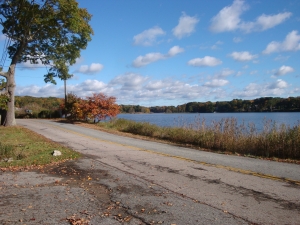Monday, December 12, 2022
“Ice cream! The best you’ll ever taste.” The voice of Timothy Whipple echoed down the Mystic River along with the splash of oars dipping into the river against the current, according to my grandmother who was born in 1896. The west side of the river in Mystic, CT, along River Road opposite Elm Grove Cemetery, was thronged with women in ankle-length summer dresses and men in suits and top hats. Many mopped their brow with white cotton handkerchiefs in the sweltering August heat as children darted in and out of the crowd. The year was 1899 and the Connecticut Peace Society, a branch of the Universal Peace Union, was holding its 32th annual meeting in the same spot where they had started in 1867. During the various speeches and conversations about world peace, some attendees rushed to the riverbank hoping to refresh themselves with a paper cone of Timothy’s hand-churned ice cream.
 Timothy Whipple, a fine chef and violinist, was not only an enterprising entrepreneur but also a descendent of Jonathan Whipple, inventor of the oral method of teaching the hearing impaired, and Jonathan’s grandson Zera C. Whipple, who founded the Mystic Oral School. It was Jonathan, an ardent pacifist from Quakertown in Ledyard, CT, who discovered the picturesque site along the river and suggested it to Alfred H. Love, head of the Universal Peace Union, as the perfect site for the meetings which drew as many as 10,000 people over three days each year.
Timothy Whipple, a fine chef and violinist, was not only an enterprising entrepreneur but also a descendent of Jonathan Whipple, inventor of the oral method of teaching the hearing impaired, and Jonathan’s grandson Zera C. Whipple, who founded the Mystic Oral School. It was Jonathan, an ardent pacifist from Quakertown in Ledyard, CT, who discovered the picturesque site along the river and suggested it to Alfred H. Love, head of the Universal Peace Union, as the perfect site for the meetings which drew as many as 10,000 people over three days each year.
Barnard L. Colby, former Editor and Publisher of The Day, whose 58-year career at the newspaper began in 1935, was able to interview eye-witnesses to the meetings, and reported: “…the peace meetings were not dry, uninteresting affairs; not everyone listened to the speeches for, indeed, not all who attended could be accommodated. Many just attended for the holiday … As the date of the great meeting drew nearer, the housewives would start making new dresses and the farmers, when they made their periodic trips to town with produce, would discuss the coming affair over the counters. The Mystic peace meeting, besides being one of the greatest pacifist gatherings in the world, was also the most joyfully heralded social affair of the state… guests stayed at the homes of friends, or at boarding houses and hotels… some stayed on the second floor of the peace temple which had replaced the tent. Many, brought their own tents and established little camps in the grove [above the Mystic River] where they ate and slept.”
The leading spirit of the meetings, according to Charles Q. Eldredge, museum owner in Old Mystic, was Alfred H. Love, an ardent pacifist from Philadelphia, PA. Love delivered heated addresses hoping to inspire universal peace. During the Civil War, Love had been drafted into the Union Army and when he expressed that war was contrary to his principles, an officer turned to a mounted officer and commanded that he “ride him down.” Just as the horse was about to strike him, the horse stumbled and fell, the officer thrown off and killed instantly.
Witnesses claimed that Love attributed his salvation to divine intervention and set out to organize peace meetings to discuss and protest war on a grand scale. Other luminaries of the Mystic peace movement included: Ida Whipple Benham, poet and author; Delight Whipple, daughter of the first local peace meeting president; Attorney Abel P. Tanner; Samuel Whipple, Rogerene Quaker (and my great-great grandfather); Constance and Vinton Ackley, and many others. The story passed down from my grandmother about cousin Timothy and the “ice cream barge on the Mystic River” led me to believe, as a child, that lasting world peace would be accompanied by mountains of chocolate ice cream.
The gigantic meetings on the river ceased in 1910 but today the Peace Sanctuary remains as a quiet place for solitary contemplation and walking in the same woods where the multitudes of peacemakers pitched their tents more than a century ago. Travelers in the 21st century are now finding their way to Mystic throughout the year for (hopefully) peaceful pursuits – and, of course, there is plenty of ice cream, of all flavors, available in downtown Mystic. The Peace Sanctuary is now bathed in obscurity and overgrown with trees. Peaceful tranquility reigns – even if peace in rest of the world remains elusive.